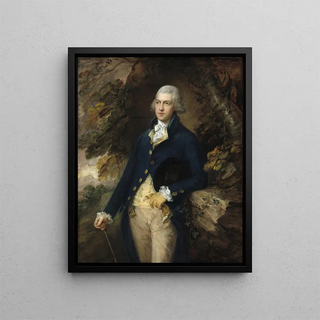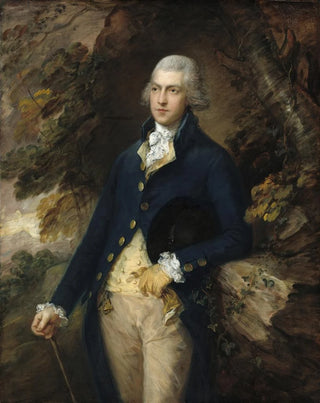Art print | Francis Basset, Lord de Dunstanville - Thomas Gainsborough


View from behind

Frame (optional)
The painting "Francis Basset, Lord de Dunstanville" by Thomas Gainsborough is an iconic work that embodies the very essence of 18th-century British portraiture. In this artwork, Gainsborough does not merely depict a noble; he captures the soul and personality of his subject with unparalleled finesse. The piece, both majestic and intimate, immerses us in a universe where nobility and nature meet, revealing the subtleties of a time when art and society intertwined harmoniously. Through this art print, we have the opportunity to rediscover not only a historical figure but also a pivotal period in art history.
Style and uniqueness of the work
Gainsborough's style is distinguished by its delicate approach and mastery of light and shadow. In "Francis Basset, Lord de Dunstanville," the fluid brushstrokes and subtle nuances of color create an almost ethereal atmosphere. The background, with its lush landscapes and luminous skies, serves as a backdrop to the central figure, which stands with quiet dignity. The clothing details, carefully painted, testify to the richness of the fashion of the period, while highlighting the personality of the noble. Lord Basset's posture, both confident and approachable, invites the viewer to ponder his life and role in society. This work is not limited to a simple portrait; it is an open window into the history and customs of a bygone era.
The artist and his influence
Thomas Gainsborough, born in 1727, is one of the greatest masters of British portrait art. His ability to capture the personality of his subjects while integrating landscape elements into his works revolutionized the genre. Gainsborough managed to combine the tradition of classical portraiture with romantic sensibility, influencing many artists who followed him. His innovative approach redefined the aesthetic standards of his time, making him an emblematic figure of the British artistic movement. Gainsborough's portraits, including that of Francis Basset, demonstrate his skill in capturing the essence

Matte finish

View from behind

Frame (optional)
The painting "Francis Basset, Lord de Dunstanville" by Thomas Gainsborough is an iconic work that embodies the very essence of 18th-century British portraiture. In this artwork, Gainsborough does not merely depict a noble; he captures the soul and personality of his subject with unparalleled finesse. The piece, both majestic and intimate, immerses us in a universe where nobility and nature meet, revealing the subtleties of a time when art and society intertwined harmoniously. Through this art print, we have the opportunity to rediscover not only a historical figure but also a pivotal period in art history.
Style and uniqueness of the work
Gainsborough's style is distinguished by its delicate approach and mastery of light and shadow. In "Francis Basset, Lord de Dunstanville," the fluid brushstrokes and subtle nuances of color create an almost ethereal atmosphere. The background, with its lush landscapes and luminous skies, serves as a backdrop to the central figure, which stands with quiet dignity. The clothing details, carefully painted, testify to the richness of the fashion of the period, while highlighting the personality of the noble. Lord Basset's posture, both confident and approachable, invites the viewer to ponder his life and role in society. This work is not limited to a simple portrait; it is an open window into the history and customs of a bygone era.
The artist and his influence
Thomas Gainsborough, born in 1727, is one of the greatest masters of British portrait art. His ability to capture the personality of his subjects while integrating landscape elements into his works revolutionized the genre. Gainsborough managed to combine the tradition of classical portraiture with romantic sensibility, influencing many artists who followed him. His innovative approach redefined the aesthetic standards of his time, making him an emblematic figure of the British artistic movement. Gainsborough's portraits, including that of Francis Basset, demonstrate his skill in capturing the essence






